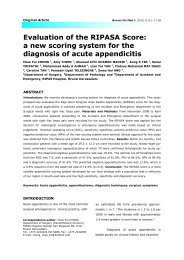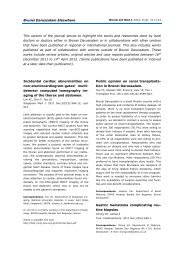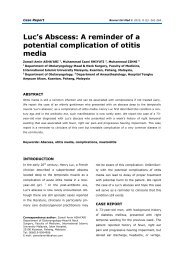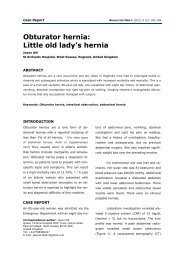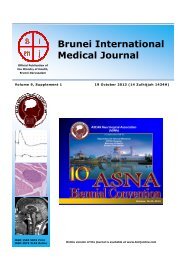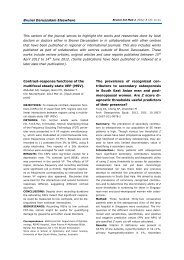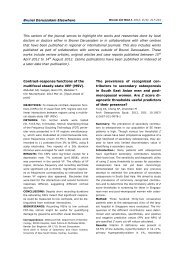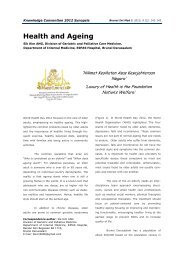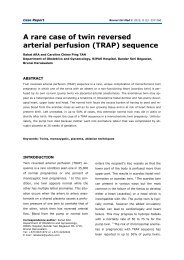BIMJ February 2012 - Brunei International Medical Journal
BIMJ February 2012 - Brunei International Medical Journal
BIMJ February 2012 - Brunei International Medical Journal
You also want an ePaper? Increase the reach of your titles
YUMPU automatically turns print PDFs into web optimized ePapers that Google loves.
<strong>Brunei</strong> Darussalam Elsewhere<br />
<strong>Brunei</strong> Int Med J. <strong>2012</strong>; 8 (1): xx-xx<br />
This section of the journal serves to highlight the works and researches done by local<br />
doctors or doctors either in <strong>Brunei</strong> Darussalam or in collaborations with other centres<br />
that have been published in regional or international journals. This also includes works<br />
published as part of collaboration with centres outside of <strong>Brunei</strong> Darussalam. These<br />
works include review articles, original articles and case reports published between 16 th<br />
December 2011 to 14 th <strong>February</strong> <strong>2012</strong>. (Some publications have been published or indexed<br />
at a later date than publication).<br />
Incidental cardiac abnormalities on<br />
non-electrocardiogram-gated multidetector<br />
computed tomography imaging<br />
of the thorax and abdomen.<br />
Lim KC, Chai F, Teo LS.<br />
Singapore Med J. 2011 Dec;52(12):906-12; quiz<br />
913.<br />
Little attention is usually paid to the heart on nonelectrocardiogram<br />
(ECG)-gated multi-detector computed<br />
tomography (MDCT) imaging of the thorax<br />
and abdomen. The current MDCT systems have fast<br />
scanning capabilities that render non-ECG-gated<br />
images with reduced cardiac motion artefacts due<br />
to greater temporal and spatial resolution. This has<br />
allowed for better evaluation of the cardiac structures.<br />
We present a pictorial review of incidental<br />
cardiac abnormalities found on MDCT imaging of<br />
the thorax and abdomen performed in our institution.<br />
We systematically describe abnormalities involving<br />
the pericardium, myocardium, cardiac<br />
valves, cardiac chambers, coronary artery and congenital<br />
heart disease. Some of these images have<br />
echocardiograph and magnetic resonance imaging<br />
correlation. The purpose of this pictorial essay is to<br />
draw attention to cardiac abnormalities found incidentally<br />
on non-ECG-gated MDCT imaging of the<br />
thorax and abdomen, which may or may not be<br />
related to the patient's symptoms.<br />
Correspondence: Teo LN. Department of Diagnostic Imaging,<br />
National University Hospital, 5 Lower Kent Ridge<br />
Road, Singapore 119074. lynette_ls_teo@nuhs.edu.sg.<br />
Dr Lim KC is currently working in the Department of Radiology,<br />
RIPAS Hospital, Bandar Seri Begawan, <strong>Brunei</strong>.<br />
Article is available free from<br />
http://http://smj.sma.org.sg/5212/5212pe1.pdf<br />
Public opinion on renal transplantation<br />
in <strong>Brunei</strong> Darussalam.<br />
Teo TT, Hossain MM, Zinna S, Liew YP, Tan J.<br />
Transplant Proc. 2011 Dec;43(10):3599-603.<br />
<strong>Brunei</strong> Darussalam is a small Muslim country with a<br />
high prevalence and incidence of kidney disease. At<br />
present, there is no local transplant program for<br />
patients on the renal replacement therapy program.<br />
In order to assess feasibility of a local transplant<br />
program, we decided to conduct a survey to assess<br />
public opinion on renal transplantation. The majority<br />
of the 300 respondents (78.7%) were willing to<br />
donate their kidneys if needed. Even after learning<br />
of the small theoretical risks of kidney failure,<br />
72.33% of all respondents were still willing to proceed<br />
with transplantation. Respondents who had<br />
relatives on dialysis and who had a higher education<br />
level were more willing to donate their kidneys.<br />
There was no significant difference between Muslims<br />
and non-Muslims. Most respondents (59.7%)<br />
preferred to have transplantation done locally. This<br />
study shows that most <strong>Brunei</strong>ans are receptive of<br />
the idea of living related kidney donations, which<br />
augurs well for the sustainability of a new program.<br />
More work is needed to overcome other barriers<br />
like the availability of surgical expertise and facilities<br />
and cost-benefit considerations.<br />
Correspondence: Jackson Tan. Department of Renal<br />
Medicine, RIPAS Hospital, Bandar Seri Begawan, <strong>Brunei</strong><br />
Darussalam.<br />
Gastric hematoma complicating routine<br />
biopsies<br />
Heng Chong V, Jalihal A<br />
Turk J Gastroenterol. 2011 Dec;22(6):650-1.<br />
Correspondence: Chong VH. Department of Medicine,<br />
RIPAS Hospital, Bandar Seri Begawan BA 1710, <strong>Brunei</strong><br />
Darussalam. E mail: chongvuih@yahoo.co.uk
<strong>Brunei</strong> Int Med J. <strong>2012</strong>; 8 (1): xx<br />
A case of breakage of LMA Supreme<br />
on its first use<br />
Simon BP.<br />
Indian J Anaesth. 2011; 55;635-6.<br />
Correspondence: Simon BP, Department of Anaesthesiology,<br />
RIPAS Hospital, Bandar Seri Begawan BA 1710,<br />
<strong>Brunei</strong> Darussalam. E mail: binusimon@yahoo.com<br />
Epidemiology of burns in a major referral<br />
hospital in <strong>Brunei</strong> Darussalam.<br />
Pande KC, Ishak HL<br />
Singapore Med J. <strong>2012</strong> Feb;53(2):124-7.<br />
Introduction: Burn injuries are a public health concern<br />
across the world, particularly in Southeast<br />
Asia, where epidemiological data is lacking. This<br />
retrospective study was conducted to assess the<br />
epidemiology of patients with burns treated at a<br />
major referral hospital in <strong>Brunei</strong> Darussalam, with<br />
particular reference to demographics and aetiology.<br />
Methods: All patients were referred to and treated<br />
at the Burns Unit, where data was recorded by the<br />
on-duty nurse on a pre-designed form at the first<br />
attendance. A total of 211 patients (111 male, 100<br />
female), comprising 10 inpatients and 201 outpatients,<br />
were treated during the study period. Results:<br />
The average age of the patients was 19.6 ±<br />
20.9 (median 10, range < 1-90) years. 67 (32%)<br />
patients were under two years of age. Scalding due<br />
to hot liquids was the most common cause<br />
(78.2%), followed by flame and contact burns. The<br />
majority of burns were sustained indoors either at<br />
home or at work (87.2%). The total body surface<br />
area (TBSA%) for the whole sample was 3.7% ±<br />
7.9% (median 2%; range 1%-90%). Patients with<br />
flame burns (n = 19) were older and had larger<br />
TBSA% (p < 0.05). Inpatients had significantly<br />
higher TBSA% compared to outpatients (28.2% ±<br />
26% versus 2.5% ± 2.1%; p < 0.005). Conclusion:<br />
Scald burns sustained indoors are the most common<br />
across all age groups. Although the TBSA is<br />
small, a large number of children are affected.<br />
There is a need for burns prevention education programme<br />
in <strong>Brunei</strong> Darussalam.<br />
Correspondence: KC Pande, Department of Orthopaedics,<br />
RIPAS Hospital, Bandar Seri Begawan BA 1710, <strong>Brunei</strong><br />
Darussalam. E mail: ketanpande@yahoo.com<br />
Utility of the electronic information<br />
resource UpToDate for clinical decision-making<br />
at bedside rounds.<br />
Phua J, See KC, Khalizah HJ, Low SP, Lim TK.<br />
Singapore Med J. <strong>2012</strong> Feb;53(2):116-20.<br />
Introduction: Clinical questions often arise at daily<br />
hospital bedside rounds. Yet, little information exists<br />
on how the search for answers may be facilitated.<br />
The aim of this prospective study was, therefore,<br />
to evaluate the overall utility, including the<br />
feasibility and usefulness of incorporating searches<br />
of UpToDate, a popular online information resource,<br />
into rounds. Methods: Doctors searched UpToDate<br />
for any unresolved clinical questions during rounds<br />
for patients in general medicine and respiratory<br />
wards, and in the medical intensive care unit of a<br />
tertiary teaching hospital. The nature of the questions<br />
and the results of the searches were recorded.<br />
Searches were deemed feasible if they<br />
were completed during the rounds and useful if<br />
they provided a satisfactory answer. Results: A<br />
total of 157 UpToDate searches were performed<br />
during the study period. Questions were raised by<br />
all ranks of clinicians from junior doctors to consultants.<br />
The searches were feasible and performed<br />
immediately during rounds 44% of the time. Each<br />
search took a median of three minutes (first quartile:<br />
two minutes, third quartile: five minutes). Up-<br />
ToDate provided a useful and satisfactory answer<br />
75% of the time, a partial answer 17% of the time<br />
and no answer 9% of the time. It led to a change in<br />
investigations, diagnosis or management 37% of<br />
the time, confirmed what was originally known or<br />
planned 38% of the time and had no effect 25% of<br />
the time. Conclusion: Incorporating UpToDate<br />
searches into daily bedside rounds was feasible and<br />
useful in clinical decision-making.<br />
Correspondence: Division of Respiratory and Critical Care<br />
Medicine, Department of Medicine, National University<br />
Hospital, National University Health System Tower Block,<br />
Level 10, 1E Kent Ridge Road, Singapore 119228.<br />
tow_keang_lim@nuhs.edu.sg.<br />
Dr Hjh Khalizah, Division of Respiratory Medicine, Department<br />
of Medicine, RIPAS Hospital, Bandar Seri Begawan<br />
BA 1710, <strong>Brunei</strong> Darussalam.



